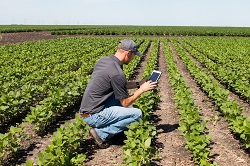Why open science matters for agriculture
The world needs to feed an extra 2 billion people by 2050, but this unprecedented challenge must be met without overwhelming natural systems. Questions such as how to grow crops without synthetic chemical pesticides, preserve biodiversity, and achieve carbon-neutral and climate-resilient agri-food systems now demand answers. Yet these questions are vast, complex and global in scope. Such issues require the concerted action of several stakeholders: citizens, farmers, private companies and researchers. People, especially researchers, need to share and connect their data and collaborate beyond the limits of national borders and scientific disciplines to address the challenges facing society. Organising the sharing of knowledge as quickly as possible is a key task. The future of agricultural research The Horizon 2020 e-ROSA project addressed this issue by designing a long-term programme for creating an e-infrastructure for open science in agriculture. The aim was to ensure Europe’s position as a global leader in this area of research and innovation. “The initiative developed a shared vision of a sustainable e-infrastructure for research and education in agriculture based on practical recommendations reflected in a common roadmap,” says project coordinator Odile Hologne. Open science refers mainly to the evolution of research practices for fostering collaboration among researchers or beyond, like citizens and private companies. It aims to improve the sharing of knowledge and all digital resources, such as data and software, to promote innovation, and therefore plays a key role in the agri-food domain. Researchers collaborating mainly with agri-food scientific researchers and educators, as well as practitioners and EU policy makers built on existing projects, networks, and international agreements. According to Hologne: “We are mapping these initiatives and identifying priorities and solutions that will lead towards an open, digital and data intensive science for agriculture.” Stakeholders share a common vision Project partners conducted a bibliometric study to better understand who the academic stakeholders involved in agri-food and ICT sciences are and what they do. Researchers also drafted a vision paper explaining the added value of open science practices for facing societal challenges like climate change, and how digital infrastructure (e-infrastructure) can improve the sharing of knowledge. The roadmap stressed, among other things, the need to have shared semantics to better find and integrate the digital resources (data, software and so on). e-ROSA also achieved an ‘immaterial result’ – “This involves a community of international stakeholders from private and public agri-food sector who share the same vision or understanding of the challenges and agree upon solutions to better share digital resources,” claims Hologne. e-ROSA will help policy makers and funding agencies by aligning their agendas based on priorities identified in the roadmap. “The key challenge of an e-infrastructure in agri-food science is to facilitate the dissemination of knowledge, thereby reducing fragmentation of the actual landscape of digital resources and helping solve societal challenges,” Hologne concludes.



